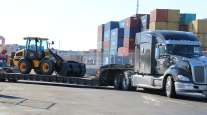Carriers Led Logistics Industry Higher in 2017, Report Says

The logistics supply chain had a strong 2017 with a healthy economy revving up demand that led to tight capacity that gave carriers the authority to raise prices with shippers, according to the 29th Annual Council of Supply Chain Management Professionals State of Logistics Report.
The report combines a review of the previous year with a look at current activities and a glance at the future.
In 2017, United States Business Logistics Costs rose 6.2% to $1.49 trillion, or 7.7% of GDP, in contrast to a decline in 2016, according to A.T. Kearney, the management consulting firm that prepared the report. The environment today is positive with growing inventories, rising household spending and a lower corporate tax rate spurring business investment. The report was written for CSCMP and presented by Penske Logistics.
Costs on the transportation side rose 7% to $965.5 billion. Under the transportation umbrella full truckload rose 6.4% to $289.4 billion, while less-than-truckload grew 6.6% to $62.4 billion and dedicated carriers saw growth of 9.5% to $289.6 billion. Parcel costs rose 7% to $99 billion. Rail transportation costs grew 8.2% to $80.5 billion.
The biggest winners were the motor carriers with costs rising 7.8% in 2017 to $641.4 billion. “Carriers gained pricing power as demand rose and electronic logging mandates exacerbated driver shortages,” according to the report from lead writer Sean Monahan, a Kearney partner.
For carriers “the most significant development of the year was” the 20-30% surge in spot rates and a 5-15% increase in contract rates. But the capacity that typically rises in response to price increases never materialized.
State of Logistics Report Predicts Rapid Change via @HDTrucking Get your copy now at https://t.co/bZGE4djnCg#SofL #StateofLogistics #CSCMP @PenskeLogistics @ATKearney pic.twitter.com/2YXI6xmq3P — cscmp (@cscmp) June 21, 2018
Railroads had a solid 2017 with total carloads growing 3% to 3.1 million while price hikes generated greater revenues. But the future shows greater competition from over-the-road semi-autonomous trucks, the report predicted.
Third-party logistics firms are in the middle of a growth period. The market for 3PLs will grow 5.5% from 2017 through 2019, driven primarily by their transportation management operations. There is mutual mistrust between shippers and 3PLs that “prevents them from forging long-term strategic partnerships that would unlock greater growth for 3PLs,” according to the report.
Kearney has a sunny view for the industry, though it notes there are such challenges as capacity issues, crumbling infrastructure and trade tensions.
The CSCMP released the report June 19 at the National Press Club in Washington, and presented a panel discussion with five logistics experts representing carriers, shippers, railroads, ports and 3PLs.
The discussion included Joe Carlier, senior vice president, Penske Logistics; Cheryl Capps, vice president, Corning Inc.; Sylvia Fouhy, vice president, Johnson & Johnson; Erik Hansen, vice president intermodal, Kansas City Southern; and Joseph Ruddy, chief innovation officer, Port of Virginia. The panel moderator was Kevin Smith, CEO, Sustainable Supply Chain Consulting.
The two topics that generated the most discussion were capacity issues and new technology that could impact the entire supply chain.
Capacity challenges drew a mixed response from the panelists.
For Penske, the driver shortage is a giant problem.
There’s only a trickle of new drivers in the pipeline to replace today’s 55-year-old driver looking to retire in five years, said Penske’s Carlier.
“It’s all about people, people, people,” said Carlier. “We see a lot exiting the business.”
Penske is looking for ways to better use its driver assets but in the near-term there aren’t a lot of solutions.
Railroads too have an issue with attracting new engineers and filling positions on its trains, said Hansen of Kansas City Southern.
But the issue was not an emergency for a shipper like Corning, a provider of products in telecommunications, auto, pharmaceuticals and other industries, said Capps.
“We feel the effects of the capacity constraints (but) it’s mostly a nuisance,” said Capps. It takes longer to recover from events like last fall’s hurricanes or a daily problem like a truck tip-over.
In response, Corning is turning to technology to improve its flexibility, said Capps.
Johnson & Johnson works to be the shipper of choice with its carriers, said Fouhy.
Technology showed great promise but some were skeptical about claims that self-driving trucks will be carrying most of the nation’s freight.
Port of Virginia’s Ruddy said it is carefully watching developments in autonomous trucking. For now, it looks like “significant automation of vehicles and trucks will occur before longhaul drivers are replaced,” said Ruddy.
And the rise in technology is a plus for the industry as it seeks to attract young people to the profession, said Carlier.
“It increases awareness of the supply chain. Trucks are highly technical. It can help to make it cool,” Carlier said.




